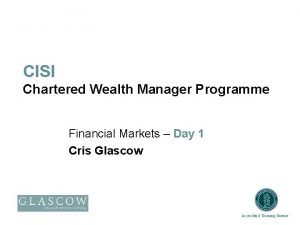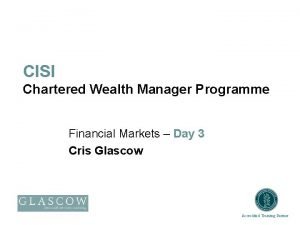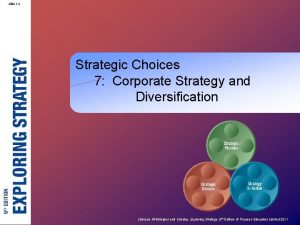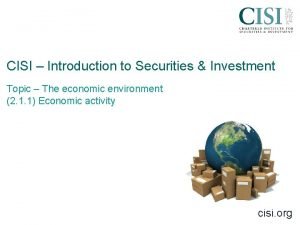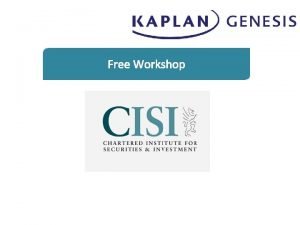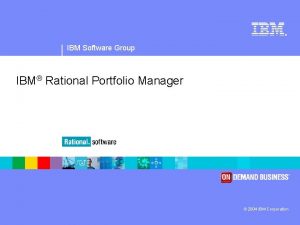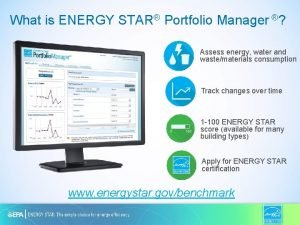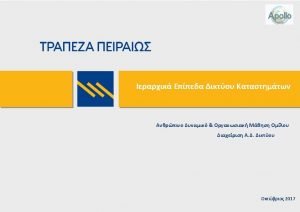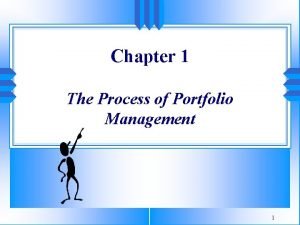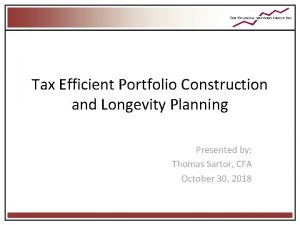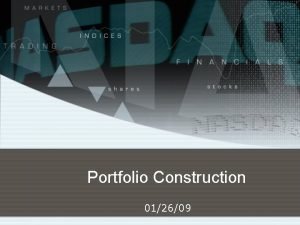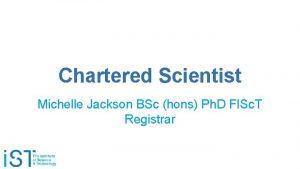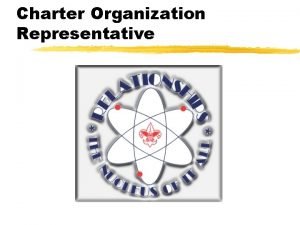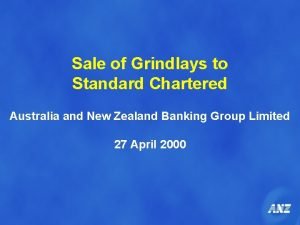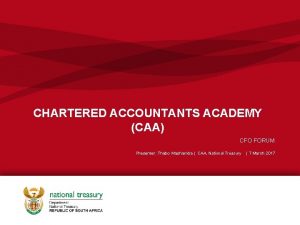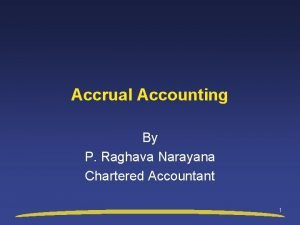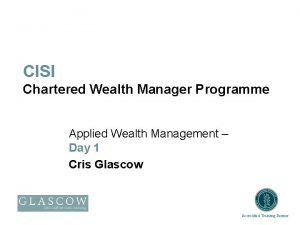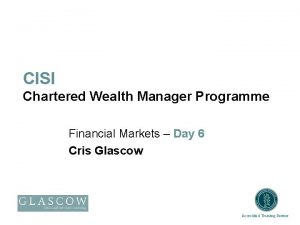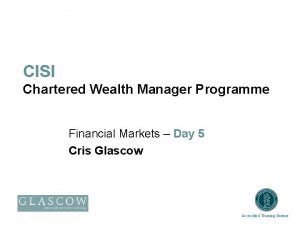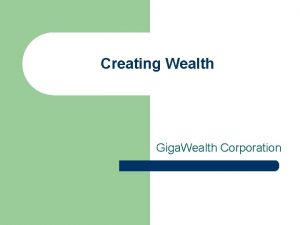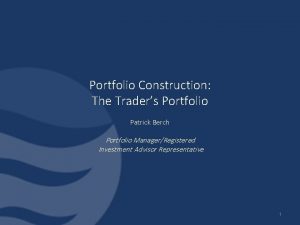CISI Chartered Wealth Manager Programme Portfolio Construction Theory


































- Slides: 34

CISI Chartered Wealth Manager Programme Portfolio Construction Theory – Day 3 Cris Glascow Accredited Training Partner

Objectives By the end of the workshop you will have: q q Mock test – Days 1 and 2 Revised learning outcomes 7, 8 and 9 Practised exam type questions Identified areas you need to read about more thoroughly q Devised an action plan. Accredited Training Partner

Agenda q q q Mock Test Days 1 and 2 Module 7 Module 8 Module 9 Review. Accredited Training Partner

Module 7 – Efficient Markets Hypothesis Accredited Training Partner

Efficient Markets Hypothesis “EMH” q Two main methods of stock analysis / valuation: o. Technical analysis § Chartism § Try to predict prices from past patterns o. Fundamental analysis § Try to ascertain the intrinsic values of stocks and shares. Accredited Training Partner

Efficient Markets Hypothesis “EMH” q Considers the extent to which information is priced into a share by the market q The more efficient the market, the more quickly information is priced in to the share and the less opportunity there is to find undervalued stocks q Not all markets are the same – comes in three forms. Accredited Training Partner

EMH – Weak Form Efficiency q All historical information relating to share price movements and patterns in change are fully reflected in the current market share price q Implication - there is nothing in the past price movements of a share price / market generally that can be used to forecast future prices q Technical analysis cannot be used to generate excess returns (it uses historical information to construct charts) Future prices random – “random walk theory” Accredited Training Partner

EMH – Semi-strong Form Efficiency q All historical information and all other relevant publicly available information is fully reflected in the current market share price q Implication - new information is priced into the share price immediately. Investors cannot make excess returns from the release of new information q Fundamental analysis cannot be used to generate excess returns (fundamental analysts are analysing publicly available information to make judgements) – Only inside information can generate excess returns. Accredited Training Partner

EMH – Strong Form Efficiency q All information which can possibly be acquired (historical, public and private) is priced into the stock. q Implication - the markets move so quickly to price in information that no-one can consistently produce excess returns. This form suggests that inside information cannot produce excess returns – evidence would suggest otherwise! q Market is so efficient it reacts immediately to news and information! Accredited Training Partner

Challenges to EMH and EMH response q Subjective aspects to technical trading strategies q Time perspective q Investor rationality q Availability of all relevant information q Share prices are a “social fact” q Investment management skill or luck? q Arguably, the more people try to disprove EMH the stronger it becomes. Accredited Training Partner

Selection Strategies q An overpriced security is one that has an expected return that is less than should be expected on a risk adjusted basis q An underpriced security has an expected return that is more on a risk adjusted basis than would be expected q In terms of CAPM, a security is mispriced when it does not line on the Securities Market Line. Accredited Training Partner

Active Equity Strategies q Value investing q Growth at a reasonable price (GARP) q Fundamental analysis q Technical analysis q Quantitative funds. Accredited Training Partner

Passive Equity Strategies q Buy and hold q Indexation q Duplication or complete indexation q Stratified sampling q Factor matching q Co-mingling q Impact of tracking error. Accredited Training Partner

Active Bond Strategies q Duration switching q Riding the yield curve q Bond switching: o Anomaly switching e. g. substitution switching, pure yield pick up switch o Policy switching e. g. changes in interest rates, structure of yield curve, bond ratings, tax. Accredited Training Partner

Passive Bond Strategies 3 main strategies: q. Duration matching (or immunisation) q. Cash flow matching (or dedication) q. Combination matching (or horizon matching). Accredited Training Partner

Passive Bond Strategies Duration matching or immunisation £ Reinvestment loss becomes greaterl Capital gain diminishes Duration of the bond Time Accredited Training Partner

Passive Bond Strategies Simple strategies for matching a 20 year liability: q Bullet portfolio q. Buy a bond with a duration of 20 years q Focused portfolio q. Invest 50% of the fund in bonds with a duration of 18 years and 50% in bonds with a duration of 22 years q Barbell portfolio q. Invest 45. 5% of the fund in bonds with a duration of 8 years and 54. 5% in bonds with a duration of 30 years q. But could introduce greater immunisation risk. Accredited Training Partner

Passive Bond Strategies q Immunisation risk q. Risk of a non parallel shift in the yield curve q Rebalancing q. Need to rebalance over time as immunisation risk changes duration of bonds held q. Alternative could hold zero coupon bonds if available (possibly gilt strips) q Multi-period immunisation q. Complex funds may have several different liabilities which will need managing q Dispersion q. The need for assets to mature to meet liabilities q. Ladder strategies. Accredited Training Partner

Passive Bond Strategies q. Cash flow matching (or dedication) q. Simpler approach q. Redemption proceeds and coupons of bonds match the liabilities as they fall due q. Combination matching (or horizon matching) q. Part cash flow matching part immunisation q. E. g. Rebalance each year, firstly cash flow match for the coming year only then immunise for the longer term. Accredited Training Partner

Module 8 – Fund Management Accredited Training Partner

Approach To Fund Management Fund objectives Evaluate performance Asset selection Establish investment philosophy Develop fund strategies Accredited Training Partner

Role of The Fund Manager (1) Maximising returns for a specified threshold of risk: q Client risk preferences q Liability matching q Participants in meta market information q Time horizon q Currency risk q Liquidity constraints q Tax status q Legal and ethical constraints. Accredited Training Partner

Role of The Fund Manager (2) Type of client: Discretionary & nondiscretionary Pension funds Insurance companies Accredited Training Partner

Role Of The Fund Manager (3) Selecting a fund manager: q. Past performance q. Consistency of management personnel q. Internal risk controls and regulation q. Fees and Managers’compensation. Accredited Training Partner

Fund Management Approaches (1) Top down: qasset allocation q. Market timing or tactical asset allocation q. Stock selection Bottom up: qfundamental analysis of individual stocks to best satisfy fund’s objectives and constraints. Accredited Training Partner

Fund Management Approaches (2) q. Macro-based strategies q. Foreign exchange issues q. Quants based fund management q. Ethical and socially responsible investment. Accredited Training Partner

Investment Stewardship And Regulation (1) q Dividends q Information disclosure q Voting q Oversight and engagement q Litigation q Responsible and ethical investment. Accredited Training Partner

Investment Stewardship And Regulation (2) UK Corporate Governance Code - principles q Leadership q Effectiveness q Accountability q Remuneration q Relations with shareholders. Handout 1 Comply or explain Accredited Training Partner

Investment Stewardship and Regulation (3) The Walker Report – 2009 Following the banking crisis, Sir David walker recommended substantial changes to the way boards of banks and big financial institutions function in regards to Corporate Governance. Some of the recommendations included: • Board level risk committees to be chaired by a non-executive • Risk committees to have power to scrutinise and if necessary to block big transactions • More power for remuneration committees to scrutinise firm wide pay • Significant deferred element in bonus schemes for all high paid executives • FRC to sponsor institutional shareholder code Accredited Training Partner

Investment Stewardship and Regulation (4) UK Stewardship Code – principles So as to protect and enhance the value that accrues to the ultimate beneficiary, institutional investors should: 1. publicly disclose their policy on how they will discharge their stewardship responsibilities. 2. have a robust policy on managing conflicts of interest in relation to stewardship which should be publicly disclosed. 3. monitor their investee companies. 4. establish clear guidelines on when and how they will escalate their stewardship activities. 5. be willing to act collectively with other investors where appropriate. 6. have a clear policy on voting and disclosure of voting activity. 7. report periodically on their stewardship and voting activities. Accredited Training Partner

Investment Stewardship and Regulation (5) Handout 2 Exercise – Stewardship code Exam question June 2011 As part of your monitoring activity as a wealth manager, you review the corporate governance of UK banks held in your discretionary client account equity portfolios. You see that one large UK listed commercial bank has 3 board committees; nominations, remuneration and audit. Your firm has signed-up to the UK Stewardship Code. In order to meet good standards of corporate governance and investor stewardship what steps would you now follow? (5 marks) Accredited Training Partner

Module 9 – Ethical Investment Accredited Training Partner

Ethical investment q q q Key features Corporate social responsibility Investment screening Sources of information Investment performance and benchmarks. Accredited Training Partner

Homework q Assignment 1 q Questions relating to Module 7 q Deadline. Accredited Training Partner
 Cisi financial markets
Cisi financial markets Chartered wealth manager cisi
Chartered wealth manager cisi Applied wealth management
Applied wealth management Portfolio manager synergy manager parental developer
Portfolio manager synergy manager parental developer Millennium 3 financial services
Millennium 3 financial services Cisi introduction to securities and investment
Cisi introduction to securities and investment Cisi or cfa
Cisi or cfa Weebly portfolio examples
Weebly portfolio examples Ibm rational portfolio manager
Ibm rational portfolio manager Rational portfolio manager
Rational portfolio manager Energy star portfolio manager tutorial
Energy star portfolio manager tutorial Ibm rational portfolio manager
Ibm rational portfolio manager Senior manager vs general manager
Senior manager vs general manager Construction studies leaving cert
Construction studies leaving cert Portfolio construction management and protection
Portfolio construction management and protection Efficient portfolio construction
Efficient portfolio construction Limitations of markowitz model
Limitations of markowitz model Hong kong institute of chartered secretaries
Hong kong institute of chartered secretaries Ciwem membership
Ciwem membership Chartered developments
Chartered developments Lost at sea ranking chart answer key
Lost at sea ranking chart answer key Initial professional development
Initial professional development Cgeol
Cgeol Chartered scientist
Chartered scientist Bcs student membership
Bcs student membership Chartered organization representative
Chartered organization representative Standard chartered australia
Standard chartered australia Chartered secretaries southern africa
Chartered secretaries southern africa Chartered project professional
Chartered project professional Dilignece
Dilignece International professional engineer
International professional engineer Cipd self-assessment examples
Cipd self-assessment examples Term and reversion valuation
Term and reversion valuation Accountants academy
Accountants academy Accrue chartered accountants
Accrue chartered accountants
